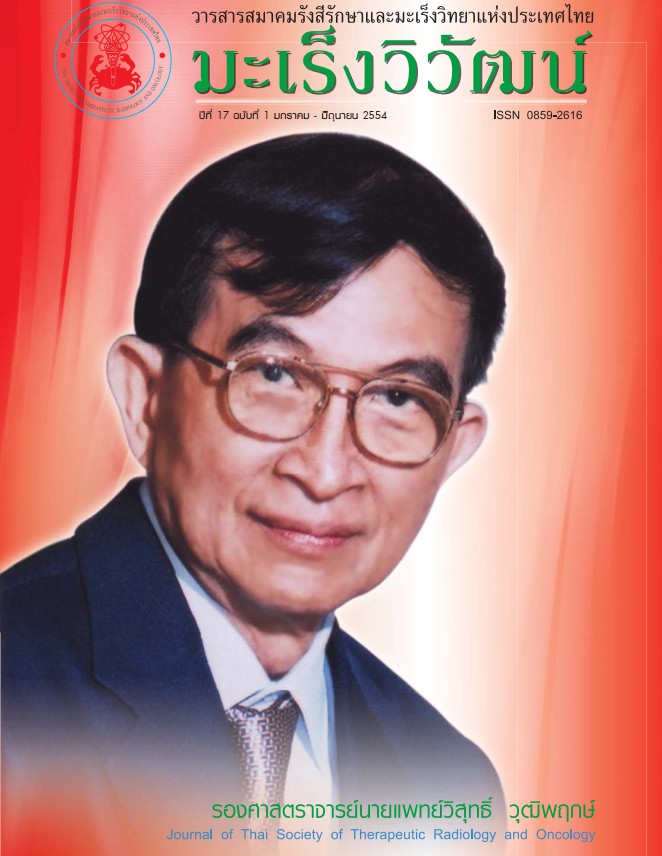Prevalence of Hypothyroidism Following Radiotherapy of Nasopharyngeal Cancer Patients in Srinagarind Hospital between 1994 and 2007
Keywords:
Hypothyroidism, Nasopharyngeal cancer, RadiotherapyAbstract
Objectives : To investigate the frequency and severity of hypothyroidism following external beam radiotherapy to head and neck region in the treatment of nasopharyngeal cancer and to evaluate factors related with prevalence of hypothyroidism. Methods and Materials: Patients with non-metastatic nasopharyngeal cancer treated with radiotherapy to head and neck region in Srinagarind hospital between January 1994 and December 2007. These patients were evaluated thyroid function (TSH and FT4) and symptoms of hypothyroidism when they came to be followed up after complete radiotherapy. Then the patient’s data were reviewed regarding to age, gender, image fi ndings, staging, histopathology, radiation fi elds, radiation dose, chemotherapy and clinical status. Results : Eighty fi ve nasopharygeal cancer patients were enrolled to evaluate thyroid function. Ten patients (12%) have developed hypothyroidism, fi ve of them were classifi ed as central hypothyroidism, and fi ve were primary hypothyroidism. Seven patients had subclinical hypothyroidism and three patients had clinical hypothyroidism. The latent period of hypothyroidism ranged between 5 months to 15 years after complete radiotherapy. In clinical hypothyroid patients, clinical presentations were not so obvious. From statistical analyses, only latency of post-radiation time showed signifi cant infl uence to development of primary hypothyroidism and adjuvant chemotherapy influenced the development of central hypothyroidism. Conclusion : The prevalence of hypothyroidism in our study is 12% at 15years after radiotherapy and most of the hypothyroid patients were subclinical hypothyroidism. So, we recommend thyroid function test to be a routine follow-up check for the patients who had been treated by radiotherapy to head and neck region.
References
ตั้งวรพงศ์ชัย ว. สถิติโรคมะเร็ง หน่วยรังสีรักษา โรงพยาบาลศรีนครินทร์ มหาวิทยาลัยขอนแก่น, พศ.2537-2550.
Jereczek-Fossa BA, Alterio D, Jassem J, Gibelli B, Tradati N, Orecchia R. Radiotherapy-induced thyroid disorders. Cancer treatment reviews. 2004 Jun;30(4):369-84.
Tell R, Sjodin H, Lundell G, Lewin F, Lewensohn R. Hypothyroidism after external radiotherapy for head and neck cancer. International journal of radiation oncology, biology, physics. 1997 Sep 1;39(2):303-8.
Ulger S, Ulger Z, Yildiz F, Ozyar E. Incidence of hypothyroidism after radiotherapy for nasopharyngeal carcinoma. Medical oncology (Northwood, London, England). 2007;24(1):91-4.
Kaffel N, Mnif M, Daoud J, Abid M. [Hypothyroidism after external radiotherapy. Fifteen cases]. Cancer Radiother. 2001 Jun;5(3):279-82.
Aich RK, Ranjan DA, Pal S, Naha BL, Amitabh R. Iatrogenic hypothyroidism: a consequence of external beam radiotherapy to the head & neck malignancies. Journal of cancer research and therapeutics. 2005 Jul-Sep;1(3):142-6.
Samaan NA, Vieto R, Schultz PN, Maor M, Meoz RT, Sampiere VA, et al. Hypothalamic, pituitary and thyroid dysfunction after radiotherapy to the head and neck. International journal of radiation oncology, biology, physics. 1982 Nov;8(11):1857-67.
Y. Wu JTC. Hypothyroidism after radiotherapy for nasopharyngeal cancer patients Eur J Cancer. 2005; October 2005;supplements,volume 3.((issue 2)):290.
Kupeli S, Varan A, Ozyar E, Atahan IL, Yalcin B, Kutluk T, et al. Treatment results of 84 patients with nasopharyngeal carcinoma in childhood. Pediatric blood & cancer. 2006 Apr;46(4):454-8.
Zubizarreta PA, D'Antonio G, Raslawski E, Gallo G, Preciado MV, Casak SJ, et al. Nasopharyngeal carcinoma in childhood and adolescence: a single-institution experience with combined therapy. Cancer. 2000 Aug 1;89(3):690-5.
Samaan NA, Bakdash MM, Caderao JB, Cangir A, Jesse RH, Jr., Ballantyne AJ. Hypopituitarism after external irradiation. Evidence for both hypothalamic and pituitary origin. Annals of internal medicine. 1975 Dec;83(6):771-7.
Nishiyama K, Tanaka E, Tarui Y, Miyauchi K, Okagawa K. A prospective analysis of subacute thyroid dysfunction after neck irradiation. International journal of radiation oncology, biology, physics. 1996 Jan 15;34(2):439-44.
Abramson JH. WINPEPI (PEPI-for-Windows): computer programs for epidemiologists. Epidemiologic Perspectives & Innovations. 1: 6 ed 2004.
Jereczek-Fossa BA AD, Jassem J, et al. Radiotherapy-induced throid disorders. Cancer Treat Rev 2004;30(4):369–84.
Tell R. ea. Long-term incidence of hypothyroidism after radiotherapy in patients with head and neck cancer. Int J Radiat Oncol Biol Phys 2004;60(2):395–400.
Al-Sarraf M. Treatment of locally advanced head and neck cancer: historical and critical review. Cancer Control. 2002 Sep-Oct;9(5):387-99.
T. S. Kehwar PD, D. Sc. & *S. C. Sharma, M.D. Use of Normal Tissue Tolerance Doses into Linear Quadratic Equation to Estimate Normal Tissue Complication Probablility [cited 2009. Febuary 26th]; Available from: http://www.rooj.com/Normal%20Tissue%20Comp.htm
Nishiyama K, Kozuka T, Higashihara T, Miyauchi K, Okagawa K. Acute radiation thyroiditis. International journal of radiation oncology, biology, physics. 1996 Dec 1;36(5):1221-4.
Nishiyama K KT, Higashihara T, et al. Acute radiation thyroiditis. Int J Radiat Oncol Biol Phys. 1996;36:1221–4.
Atahan IL ea. Thyroid dysfunction in children receiving neck irradiation for Hodgkin’s disease. Radiat Med. 1998;16(5):359–61.
Bhandare N, Kennedy L, Malyapa RS, Morris CG, Mendenhall WM. Primary and central hypothyroidism after radiotherapy for head-and-neck tumors. International journal of radiation oncology, biology, physics. 2007 Jul 15;68(4):1131-9.
Tunbridge WM ED, Hall R, et al. The spectrum of thyroid disease in a community: The Whickham survey. Clin Endocrinol (Oxf) 1977(7.):481–93.
Petersen K LG, Lundberg PA, et al. . Thyroid disease in middle-aged and elderly Swedish women: Thyroid-related hormones, thyroid dysfunction and goitre in relation to ageand smoking. J Intern Med 1991;229:407–13.
Posner MR ET, Miller D, et al. . Incidence of hypothyroidism following multimodality treatment for advanced squamous cell cancer of the head and neck. Laryngoscope 1984;94:451–4.
Al-Sarraf M, LeBlanc M, Giri PG, Fu KK, Cooper J, Vuong T, et al. Chemoradiotherapy versus radiotherapy in patients with advanced nasopharyngeal cancer: phase III randomized Intergroup study 0099. J Clin Oncol. 1998 Apr;16(4):1310-7.
Greene F PD, Fleming l. AJCC cancer staging manual. 6th edition ed. New York : Springer-Verlag 2002.
Fleming ID CJ, Henson DE, et al. . American Joint Committee on Cancer : Manual for Staging of Cancer 5th ed. ed. Philadelphia: Lippincott- Raven 1998.
Beahrs OH HD, Hutter DE, Kennedy BJ. . American Joint Committee on Cancer: Manual for Staging of Cancer. 4th ed. ed. Philadelphia: : Lippincott 1992.
Downloads
Published
How to Cite
Issue
Section
License
บทความที่ได้รับการตีพิมพ์เป็นลิขสิทธิ์ของวารสารมะเร็งวิวัฒน์ ข้อความที่ปรากฏในบทความแต่ละเรื่องในวารสารวิชาการเล่มนี้เป็นความคิดเห็นส่วนตัวของผู้เขียนแต่ละท่านไม่เกี่ยวข้องกับ และบุคคลากรท่านอื่น ๆ ใน สมาคมฯ แต่อย่างใด ความรับผิดชอบองค์ประกอบทั้งหมดของบทความแต่ละเรื่องเป็นของผู้เขียนแต่ละท่าน หากมีความผิดพลาดใดๆ ผู้เขียนแต่ละท่านจะรับผิดชอบบทความของตนเองแต่ผู้เดียว




